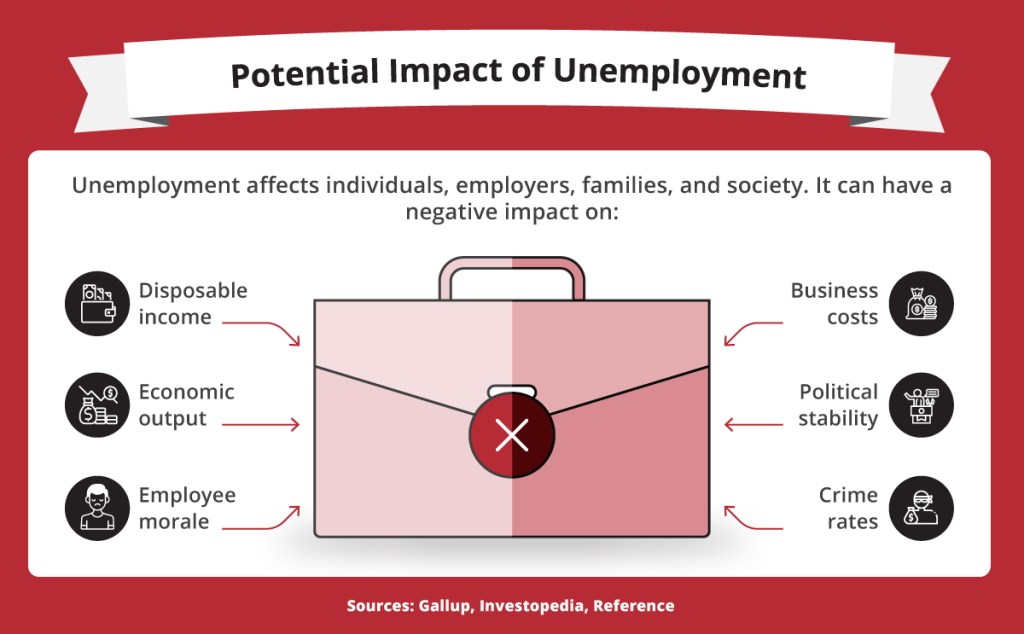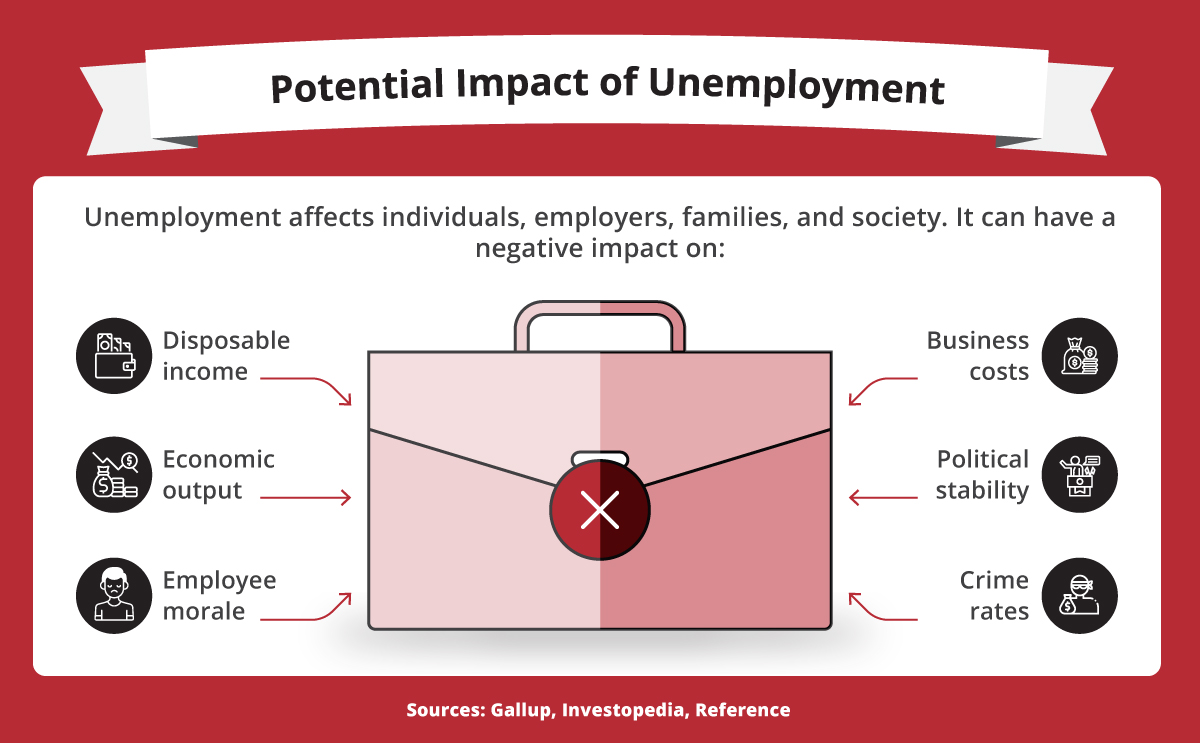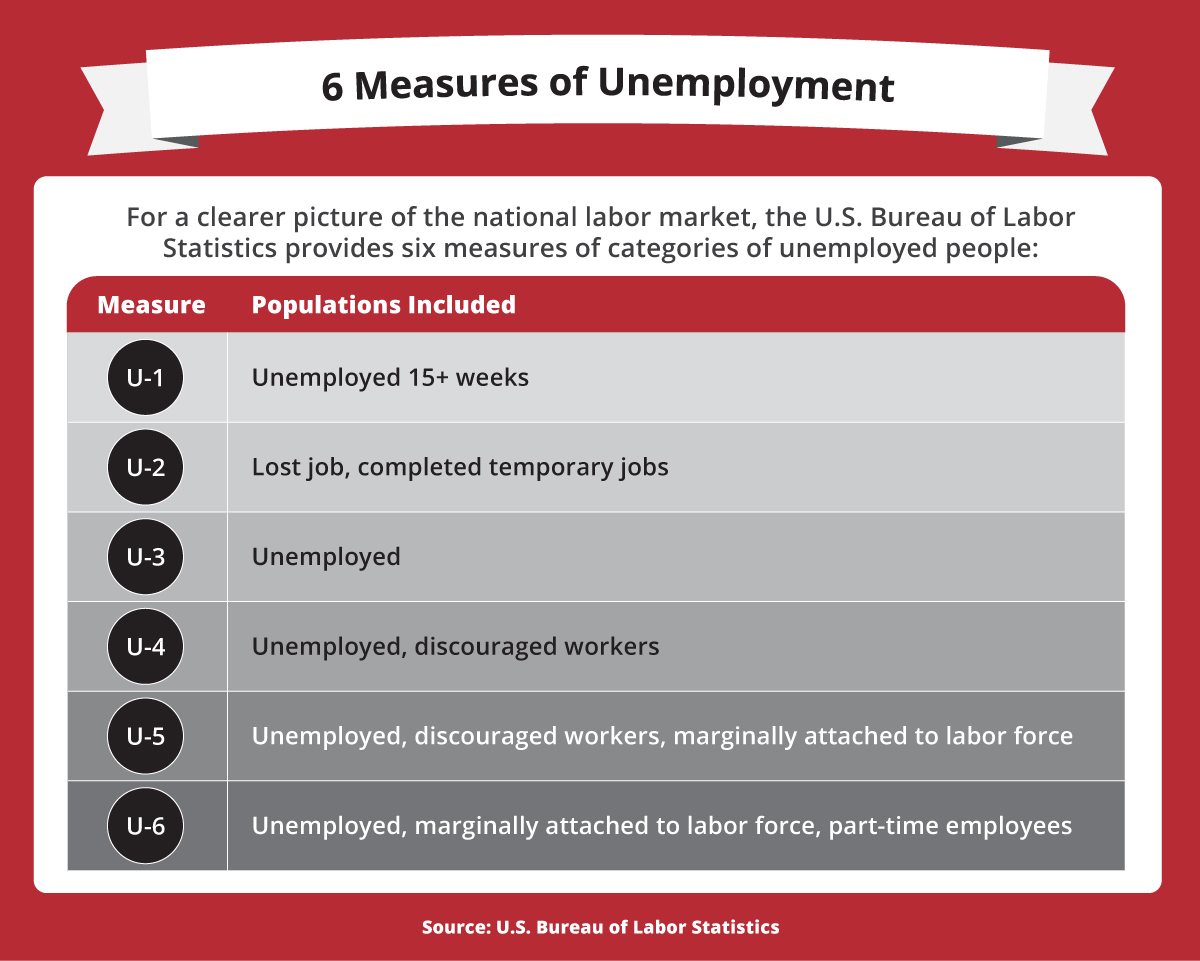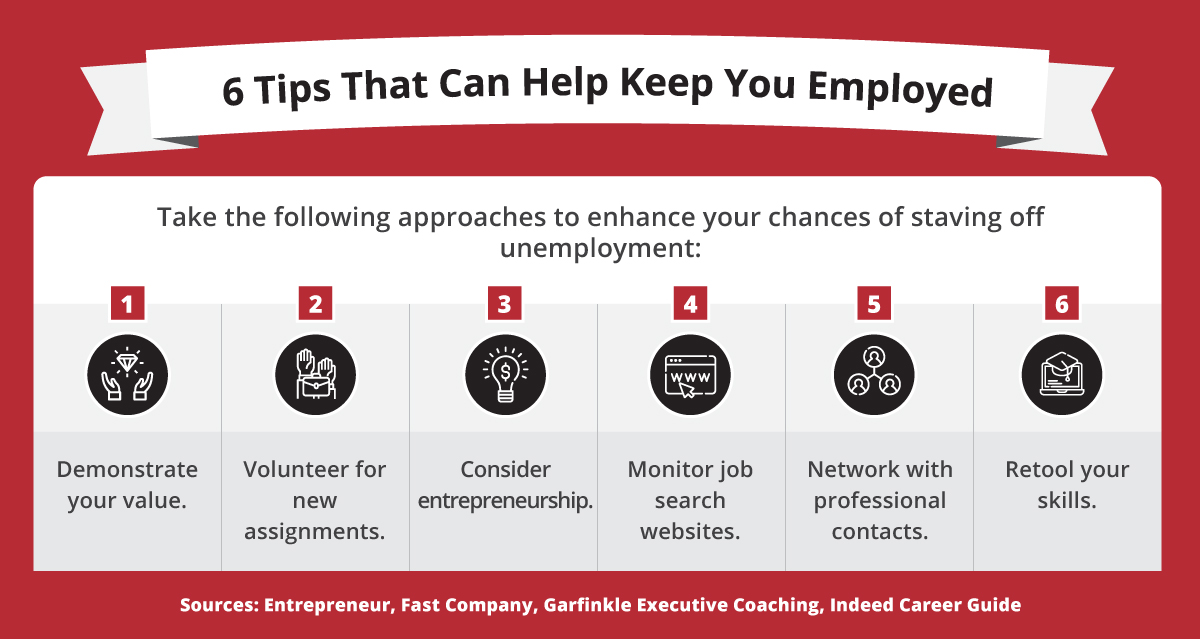8 Types of Unemployment: Understanding Each Type

Tables of Contents
Unemployment is when a person who’s actively seeking employment can’t find work — but its effects go beyond any one individual looking for a job. Unemployment also has implications for families, employers, and the economy. The U.S. has regularly tracked unemployment as a measure of economic health since 1940, using the Current Population Survey (CPS): a household survey that polls individuals from various areas in each state to calculate the rate of unemployed individuals. The topic historically has taken on added prominence during times of economic upheaval; such times are often tied to unemployment rates and the factors driving them. The effects of COVID-19, for example, have thrust unemployment issues into the spotlight as the world adapts to pandemic-related disruptions.
What Is Unemployment?
Defining unemployment requires not only a look at the issue itself but also an examination of the many types of unemployment. It requires a consideration of what unemployment means to individuals and society.
Definition of Unemployment
The U.S. Bureau of Labor Statistics (BLS) classifies people as unemployed if they meet all the following criteria:
- They weren’t employed during the week of the CPS measurement.
- They were available to work, except for temporary illness.
- They attempted to find a job during the four-week period that ended with the week of the survey, or they were temporarily laid off.
Eligibility for unemployment benefits isn’t a BLS criterion for being classified as unemployed.
However, this basic answer to the question, “What is unemployment?” doesn’t tell the whole story. Breaking down different types of unemployment helps to identify the many factors that can lead to unemployment. Some measures of unemployment include additional groups, such as discouraged workers who aren’t looking for work and those who are working less than full time despite their desire to have full-time roles.
The two broadest categories of unemployment are voluntary and involuntary. People who are voluntarily unemployed left their jobs willingly in search of another job. Those who are involuntarily unemployed have been fired or laid off and now must find another job.
Effects of Unemployment
Because of unemployment’s far-ranging consequences, it’s important to understand joblessness, the different types of unemployment, and how to avoid becoming unemployed. Following are some of the groups that unemployment can affect:
Unemployed Workers and Families
When workers are unemployed, they lose wages and purchasing power, losses that could leave them unable to afford basic needs, such as quality healthcare and nutrition. Unemployed individuals no longer contribute to the economy by providing goods or services, and that also can lead to an erosion of their skills. Additionally, when people lose their jobs, they may face depression, anxiety, and loss of self-esteem; sometimes those issues can lead to divorce, domestic violence, or even suicide.
Employers
Unemployment costs employers time and money. When an employee leaves a job, whether voluntarily or involuntarily, the company incurs costs in finding, hiring, and training a replacement. Work Institute reports that in 2019 alone, volunteer employee turnover cost U.S. companies $630 billion. Additionally, turnover can cause damage to employee morale and, depending on the circumstances of the termination, damage to the corporate brand.
The Economy
Unemployment has the potential to plunge the economy into recession. Consumer purchases help fuel the U.S. economy — and when unemployed workers have less discretionary income, their consumption typically declines. Less spending power means less money to purchase goods that others have produced, potentially jeopardizing their jobs as well. Meanwhile, state and federal governments can’t collect the same level of income tax when unemployment rates are high, and they typically must spend more for unemployment benefits.
Society
Widespread unemployment can lead to increases in crime, in some cases leading people to illegal activities to make ends meet or to fill idle time. Unemployment concerns can also lead to anti-government activism that feeds political instability. Additionally, a surplus of available workers who are competing for scarce jobs can allow for less-favorable working conditions.

Unemployment affects individuals, employers, families, and society, according to Gallup, Investopedia, and Reference. It can have a negative impact on disposable income, economic output, employee morale, business costs, political stability, and crime rates.
Understanding Unemployment Statistics
The BLS tracks unemployment statistics through surveys, census counts, and the number of unemployment claims. Using the CPS, the BLS collects information from about 110,000 individuals each month. The survey includes people from various areas in each state and the District of Columbia, in an effort to reflect the entire U.S. population.
Each month, the BLS announces the total number of employed and unemployed people in the nation for the prior month. Its official measurement of unemployment divides the number of unemployed people by the labor force (the labor force is the total number of people in the nation who are available to work).
Significance of Unemployment Rates
Unemployment rates are a key economic indicator because they show the ability of workers to readily find gainful employment and contribute to economic output. High unemployment can signal an economy in distress. Generally, in the U.S., unemployment rates that reach 10% are considered high. In April 2020, at the onset of the COVID-19 pandemic, the unemployment rate reached 14.8%.
Low unemployment is generally an indicator of a strong economy, but unemployment figures that are too low can reflect an economy at risk of inflationary pressures. The Federal Reserve, the central bank of the U.S., points out that it’s impossible to know how low unemployment can drop without causing inflation. When unemployment rates dip too low, however, the lack of available workers can force companies to raise their wages and hire employees who aren’t as productive — which can mean productivity doesn’t cover the cost of new hires.
Measures of Unemployment
The BLS’s official unemployment rate typically receives widespread media attention, but that calculation of unemployment rates is just one of six measures (U-1 to U-6) that the BLS uses to inform economic policy and determine need for government aid.
To gain a complete picture of unemployment statistics, the BLS reviews factors such as:
- Number of employed people
- Number of unemployed people
- How people became unemployed
- How long people have been unemployed
- Unemployed people’s demographic information, such as gender, age, ethnicity, and education level
- Where unemployed people live
- Whether unemployment rates are increasing or decreasing
The official unemployment rate, showing the total number of unemployed people as a percentage of the labor force, is the U-3 measure.
Each BLS measure of what it calls “labor underutilization” is progressively more expansive. U-1 and U-2 define unemployment more narrowly than the official U-3 unemployment rate, so those rates are lower. U-1 and U-2 include only selected subsets of those who fit the official definition of unemployed.
U-4 to U-6, on the other hand, have broader criteria for labor underutilization, so those rates are higher than the official unemployment rate.
The most inclusive look at labor underutilization, U-6, is sometimes called the “real” unemployment rate. It includes people who are unable to find jobs as well as some who are no longer looking for work and those who are working fewer hours than they’d like.

For a clearer picture of the national labor market, the U.S. Bureau of Labor Statistics provides six measures of categories of unemployed people. U-1: Unemployed 15+ weeks. U-2: Lost job, completed temporary jobs. U-3: Unemployed. U-4: Unemployed, discouraged workers. U-5: Unemployed, discouraged workers, marginally attached to labor force. U-6: Unemployed, marginally attached to labor force, part-time employees.
Types of Unemployment
Beyond voluntary and involuntary, some unemployment types take into account factors such as the strength of the economy, length of joblessness, and workplace changes. Following are eight types of unemployment, including definitions and examples:
1. Cyclical Unemployment
The term “cyclical unemployment” refers to the variation in the number of unemployed workers during cycles of economic strength and weakness. The nation’s gross domestic product (GDP), which is the value of goods and services a nation produces during a particular time period, is an indicator of these economic ups and downs. Government officials enact economic policies to stimulate the economy and stop this type of unemployment. When demand for a product or service declines, production also goes down. This creates less need for employers to hire people who are looking for jobs, causing the unemployment rate to increase. During the early stages of the COVID-19 pandemic, for example, people were confined to their homes, leading many businesses to shut down. During this economic downturn, many employees of those businesses weren’t needed and were left unemployed. The financial crisis of 2008 provides other examples of cyclical unemployment. One instance of this type of unemployment occurred when people began to encounter problems paying for their homes even as others failed to meet the more stringent mortgage qualifications. Demand for home construction plummeted, leaving workers in that field unemployed.
2. Frictional Unemployment
Frictional unemployment is the result of people voluntarily leaving their jobs. People who’ve resigned from their jobs and graduates seeking their first jobs need time to find employment, leaving them unemployed in the interim. Looking for a job, seeking a replacement employee, and finding the right employee for a job take time, but frictional unemployment isn’t necessarily bad. This type of unemployment usually is short term, and it’s present even in a healthy economy as people leave their jobs to seek new opportunities. The economy that emerged from the COVID-19 pandemic saw frictional unemployment, for example, when employers asked employees to return to work in person after they’d worked remotely for many months. Many employees who preferred to work from home voluntarily left their jobs in search of roles that better fit their needs.
3. Structural Unemployment
Fundamental changes in the economy and labor markets, such as evolving technology, government policies, and competition, can create structural unemployment. This means that while jobs are available, the people who could fill those roles either don’t have the right skills for them or aren’t in the right location. Manufacturing employees may contribute to structural unemployment, for example, when the requirements of their jobs change, leaving them unemployed because they no longer possess the right technological skills. Another example can occur when a business moves jobs to a location that’s too far away for employees to travel to, leaving those employees without work. Structural unemployment typically lasts longer than frictional unemployment, sometimes causing an erosion of those unemployed people’s skills or leaving them discouraged from looking for work.
4. Natural Unemployment
Natural unemployment is the combination of frictional and structural unemployment. It refers to the lowest unemployment level a healthy economy can sustain without causing inflation. This type of unemployment is ever present: People are always voluntarily looking for new jobs, causing frictional unemployment, and job skill requirements are always evolving, causing structural unemployment. It’s common for people to voluntarily leave jobs and for positions to move to other parts of the world, for example, driving the natural unemployment rate.
5. Long-Term Unemployment
The BLS classifies people who’ve been unemployed for 27 weeks or more and who’ve actively sought employment in the past four weeks as long-term unemployed. Cyclical and structural unemployment drive long-term unemployment. The 2008 recession, for example, caused a large increase in cyclical unemployment. Some individuals who were unemployed for a long time as a result of the economic downturn found themselves no longer fit for the skills the jobs required, driving structural unemployment. The repercussions of long-term unemployment for individuals can also have a negative effect on the economy. That can contribute to more cyclical unemployment — and lead to more long-term unemployment.
6. Seasonal Unemployment
Seasonal jobs are limited to a certain time period, sometimes leaving people who work in those jobs without employment after the season ends. Seasonal unemployment is the result of the decreased demand in labor that occurs at each season’s end, making the seasonal rate more predictable than other types of unemployment. Seasonal unemployment often occurs in tourist areas, where attractions often are open only during a certain time of the year. Theme parks, for example, employ workers only during their operational seasons, which in many climates is limited. A ski lodge’s employees generally work only when people are skiing. Agricultural workers’ jobs are timed to when crops are in season.
7. Classical Unemployment
Classical unemployment, also known as real-wage unemployment, occurs when real wages, or the cost of employing a worker, are too high. This circumstance leaves companies unable to afford all the workers who are available.
When real wages are too high, they’re greater than the benefit the employer gets from the labor an employee provides. Companies that can’t afford real wages decide not to hire as many people as are seeking jobs. An example of classical unemployment is when workers negotiate for a minimum salary that’s more than what a company can afford, making hiring those employees too costly for that company and leaving those workers unemployed.
8. Underemployment
Underemployment differs from unemployment in that it describes people who are working, but aren’t employed at their full capability. Measuring underemployment shows how effectively the economy is using the labor force’s skills, experience, and work availability. Following are the categories of underemployment:
- Visible underemployment. With visible underemployment, employees work part time despite their desire to work more hours. Underemployed people, such as office employees who can find only part-time roles, may work multiple jobs to earn the equivalent of a full-time salary.
- Invisible underemployment. When individuals who can’t find a job in their chosen field take a job that isn’t in line with their experience and skills, they represent invisible underemployment. Their work often pays less than a role that’s more in line with their background would pay. A person with an engineering degree working at a coffee shop is an example of invisible underemployment.
Ways of Combating Unemployment
Both employees and employers have a role in combating unemployment. Workers can take steps to keep their current jobs while also staying ready for new opportunities. Businesses, meanwhile, can work to retain their employees.

The following approaches can enhance your chances of staving off unemployment, according to Entrepreneur, Fast Company, Garfinkle Executive Coaching, and Indeed Career Guide: demonstrate your value, volunteer for new assignments, consider entrepreneurship, monitor job search websites, network with professional contacts, and retool your skills.
Employee Tips for Combating Unemployment
Key actions can help put employees in the best position to retain their jobs. Following are some ways that individuals can demonstrate their value to their companies:
Tout Achievements
Individuals should make themselves visible to their management teams. They should demonstrate their value by regularly keeping management informed of on-the-job achievements.
Show Flexibility
A willingness to learn new skills and take on new assignments is important for employees who want to show their flexibility. These actions are also evidence of a good attitude.
Become an Entrepreneur
Pursuing entrepreneurship can be a good way to provide employment for oneself, and eventually hire others. Conducting thorough research to uncover areas of potential growth and concentrating on outstanding customer service can help put a business on the path to success.
Search Online
Company websites, social media, news and trade publications, and industry associations are good sources of information about employers and trends. These sites provide information about who’s hiring, the mission and vision of potential employers, and which industries are growing.
Ask Personal and Professional Contacts
Asking contacts, such as friends, family, and professional referrals, for job suggestions and assistance is a good strategy for finding roles that are a good fit. They can offer details about their past and current employers and provide connections to employers who are hiring.
Use Job Search Services
Online job sites, college career services, recruitment agencies, job fairs, and state departments of labor can help with finding employment. In some cases, they can facilitate training for new skills.
Unemployment Resources
Tools and organizations can get unemployed individuals connected to benefits and a new job. The following are among those resources:
- gov — The federal government offers a help center with information such as unemployment resources, COVID-19 benefits, and hotline information.
- Best Job Search Websites — The Balance Careers reviews job sites to highlight the best.
- CareerOneStop — The U.S. Department of Labor offers tips for using online tools to make connections and research jobs.
- gov — The federal government provides unemployment information including links related to unemployment benefits, insurance coverage, workers’ compensation, and financial assistance.
Employer Tips for Combating Unemployment
Employers can help prevent unemployment by keeping their current employees on board. The following are some steps companies can take to retain workers:
Communicate with Employees
Gallup reported in 2019 that of workers who voluntarily left their jobs, 51% indicated that no one in management asked them about their job satisfaction or their role with the company in the three months before they left. Frequent conversations about employees’ experiences as well as the company’s expectations of them can help improve retention rates.
Encourage Employee Growth
Employers can encourage employees to stay by offering ways they can learn and grow. From training for new skills to new roles to pursue, good employees want challenges and equitable opportunities for moving up.
Understand Unemployment and How to Address It
Unemployment has implications not only for those who can’t find work but also for families, employers, the economy, and society. A solid understanding of unemployment statistics, the types of unemployment, and ways to address the issue can help individuals prepare for situations that can lead to unemployment — whether voluntary or involuntary.
Infographic Sources
Entrepreneur, “How Entrepreneurship Can Solve the Problem of Unemployment”
Fast Company, “Want to Future-Proof Your Career? Be Prepared to Reinvent Yourself Constantly”
Gallup, “This Fixable Problem Costs Businesses $1 Trillion”
Garfinkle Executive Coaching, “Tips to Reduce Your Chances of Being Laid Off”
Indeed Career Guide, “10 Job Searching Resources”
Investopedia, “How the Unemployment Rate Affects Everybody”
Reference, “What Are the Effects of Unemployment on Society?”
U.S. Bureau of Labor Statistics, Alternative Measures of Labor Underutilization

